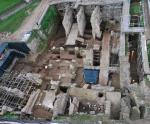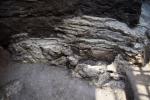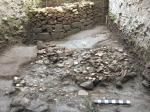Summary (English)
The excavation of Area I was completed in 2007 and Area IV in 32013/14. This season, excavations took place in Areas II and III, situated between the present via Sacra and the Piazza del Colosseo, which from the “Romulean” period have been the site of the Curiae veteres.
Lastly, the 2015 excavations clarified the function of a series of early Republican walls, which enclosed the slope, creating a series of boxes supporting the terraces and evening out the changes in height. However, a hypothesis had been put forward for the “oval” structure of room 4 that suggested it might be the wall of a room of this shape (for example the base of an oikos). This hypothesis cannot be completely rejected as the curved form of the wall is not very comprehensible, whereas the other substructures appear to be rectilinear and continued on the same alignment in subsequent phases, when further substantial rises in the floor levels of the Curiae occurred. These two proposals are not contradictory, as the “oval” wall could preserve the line of a structure with a curved wall (ancient hut?).
The excavations uncovered evidence from various chronological horizons (from the archaic to late-Republican periods), and the late-archaic/proto-Republican stratigraphies were the richest in materials, documents, and information. In particular, the excavation revealed a system of substructures on the Palatine slopes, which from the mid 5th century B.C. saw the building of terraces supported by buttresses, in turn abutted by soil. These dumps of soil artificially raised the occupation levels. Hearths and pits bordered and covered by stones were present on the surfaces, together with the remains of food, and fragments of vessels relating to the ceremonies that took place in the sanctuary (_louteria_, dolia, jars, cups, and beakers). Also present were fragments from roofing elements (slabs, tiles, imbrices) and architectural decorations from one or more buildings under reconstruction or restoration (_oikoi_, banqueting halls), which already in the 6th- early 5th century B.C. were probably present here. The most spectacular discovery was the remains of a bovine sacrifice, to be associated with the construction in the mid 5th century B.C. of a terrace that involved the entire western slope of the Palatine explored thus far. Within the stratigraphies on the south side of the hill, close to the present Piazza del Colosseo, the formations of the paleo-Tiber were identified below the late-archaic cuts and dumps, adding to the geo-morphological knowledge of the hill.
- Clementina Panella - Sapienza-Università di Roma
Director
Team
- Alessandra Pegurri - Sapienza Università di Roma
- Alessandra Vivona - Sapienza-Università di Roma
- Giacomo Pardini - Università degli Studi di Salerno
- Giordano Iacomelli - Sapienza-Università di Roma
- Giulia Schwarz - Sapienza Università di Roma
- Paolo Rosati- Università degli Studi dell’Aquila
- Viviana Cardarelli - Sapienza Università di Roma
- Francesca Romana Fiano - Sapienza-Università di Roma
- Emanuele Brienza - Università Kore (Enna)
- Gabriele Soranna
- Jacopo De Grossi Mazzorin – Università del Salento
- Sara Carraro
- Giorgia Pasquali, Lorenzo Fornaciari
- Antonio F. Ferrandes - Sapienza Università di Roma
- Marco Fano
- Salvatore Piro - ITABC - CNR
- Alessandra Celant - Sapienza-Università di Roma
- Antonia Arnoldus Huyzendveld - Studio Digiter- Roma
- Laura Orlandi - Sheila Cherubini - Elena Lorenzetti
Research Body
- Sapienza - Università di Roma
Funding Body
- Sapienza-Università di Roma, Grandi Scavi Ateneo






![Download [PDF]](/excavation/skins/fasti/images/results/download_sml.png)

